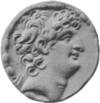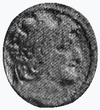| Seleucids Σελευκίδαι | |
|---|---|
| 312 BC – 64 BC Royal house | |
 The Vergina Sun remained a principal standard of the Seleucid dynasty, although the anchor and elephant were more prevalent. The Vergina Sun remained a principal standard of the Seleucid dynasty, although the anchor and elephant were more prevalent. | |
| Country | Syria, Persia |
| Founded | 312 BC |
| Founder | Seleucus I |
| Final ruler | Philip II Philoromaeus |
| Titles | |
| Dissolution | 64 BC |
| Cadet branches | Diodotid dynasty (Bactria)(?) |
| Periods and dynasties of Babylon | |||||||||||||||
|---|---|---|---|---|---|---|---|---|---|---|---|---|---|---|---|
| All years are BC | |||||||||||||||
Old Babylonian
|
|||||||||||||||
Kassite
|
|||||||||||||||
Middle Babylonian
|
|||||||||||||||
Neo-Assyrian
|
|||||||||||||||
Neo-Babylonian
|
|||||||||||||||
Persian
|
|||||||||||||||
Hellenistic
|
|||||||||||||||
Parthian
|
|||||||||||||||
| See also: List of kings by Period and Dynasty | |||||||||||||||
The Seleucid dynasty or the Seleucidae (/sɪˈluːsɪˌdiː/; Greek: Σελευκίδαι, Seleukídai, "descendants of Seleucus") was a Macedonian Greek royal family, which ruled the Seleucid Empire based in West Asia during the Hellenistic period. It was founded by Seleucus I Nicator, a general and successor of Alexander the Great, after the division of the Macedonian Empire as a result of the Wars of the Successors (Diadochi).
Through its history, the Seleucid dominion included large parts of the Near East, as well as of the Asian territory of the earlier Achaemenid Persian Empire. A major center of Hellenistic culture, it attracted a large number of immigrants from Greece who, encouraged by the Seleucids, formed a dominant political elite under the ruling dynasty. After the death of Seleucus I, his successors maintained the empire's strength establishing it as a Greek power in West Asia; the empire reached its height under emperor Antiochus III. From the mid-second century BC, after its defeat at the hands of the resurgent Parthian Empire, the polity entered a state of instability with slow territorial losses and internecine civil wars. The Seleucids, now reduced to a rump state occupying a small part of Syria succumbed to the Rome's annexation of their territory in 64 BC under Pompey the Great.
History
Background
Seleucus (c. 358 – 281 BC) served as an officer of Alexander the Great, commanding the elite infantry corps in the Macedonian army: the "Shield-bearers" (Greek: Ὑπασπισταί, Hypaspistai), later known as the "Silvershields" (Ἀργυράσπιδες, Argyraspides). After the death of Alexander in 323 BC, the Partition of Triparadisus assigned Seleucus as satrap of Babylon in 321 BC. Antigonus, the satrap of much of Asia Minor, forced Seleucus to flee from Babylon, but, supported by Ptolemy, the Satrap of Egypt, Seleucus returned in 312 BC. Seleucus' later conquests included Persia and Media. He agreed to a peace treaty with the Indian King Chandragupta Maurya (reigned 324-297 BC). Seleucus defeated Antigonus in the Battle of Ipsus in 301 BC and Lysimachus (King of Thrace, Macedon and Asia Minor) in the battle of Corupedium (near Sardis) in 281 BC. Ptolemy Ceraunus assassinated Seleucus later in the same year. Seleucus' eldest son Antiochus I succeeded him as ruler of the Seleucid territories in 281 BC.
Seleucid rulers
Main article: Seleucid Empire| Portrait | King | Reign (BC) | Consort(s) | Comments |
|---|---|---|---|---|
 |
Seleucus I Nicator | Satrap 320–315, 312–305 BC King 305–281 BC |
Apama | |
 |
Antiochus I Soter | co-ruler from 291, ruled 281–261 BC | Stratonice of Syria | Co-ruler with his father for 10 years. |
 |
Antiochus II Theos | 261–246 BC | Berenice was a daughter of Ptolemy II of Egypt. Laodice I had her and her son murdered. | |
 |
Seleucus II Callinicus | 246–225 BC | Laodice II | Brother of Antiochus Hierax |
 |
Seleucus III Ceraunus (or Soter) | 225–223 BC | Seleucus III was assassinated by members of his army. | |
 |
Antiochus III the Great | 223–187 BC |
|
Antiochus III was a brother of Seleucus III. |
 |
Seleucus IV Philopator | 187–175 BC | Laodice IV | This was a brother-sister marriage. |
 |
Antiochus (son of Seleucus IV) | 175–170 BC | Antiochus IV as co-ruler. | |
 |
Antiochus IV Epiphanes | 175–163 BC | Laodice IV | This was a brother-sister marriage. |
 |
Antiochus V Eupator | 163–161 BC | Son of Antiochus IV and Laodice IV | |
 |
Demetrius I Soter | 161–150 BC |
|
Son of Seleucus IV Philopator and Laodice IV. |
 |
Alexander I Balas | 150–145 BC | Cleopatra Thea | Son of Antiochus IV and Laodice IV. |
 |
Demetrius II Nicator | first reign, 145–138 BC | Cleopatra Thea | Son of Demetrius I. |
 |
Antiochus VI Dionysus (or Epiphanes) | 145–140 BC? | Son of Alexander Balas and Cleopatra Thea. | |
 |
Diodotus Tryphon | 140–138 BC | General who was a regent for Antiochus VI Dionysus. Took the throne after murdering his charge. | |
 |
Antiochus VII Sidetes (or Euergetes) | 138–129 BC | Cleopatra Thea | Son of Demetrius I. |
 |
Demetrius II Nicator | second reign, 129–126 BC | Cleopatra Thea | Demetrius was murdered at the instigation of his wife Cleopatra Thea. |
 |
Alexander II Zabinas | 129–123 BC | Counter-king who claimed to be an adoptive son of Antiochus VII Sidetes. | |
 |
Cleopatra Thea | 126–121 BC | Daughter of Ptolemy VI of Egypt. Married to three kings: Alexander Balas, Demetrius II Nicator, and Antiochus VII Sidetes. Mother of Antiochus VI, Seleucus V, Antiochus VIII Grypus, and Antiochus IX Cyzicenus. Coregent with Antiochus VIII Grypus. | |
| Seleucus V Philometor | 126/125 BC | Murdered by his mother Cleopatra Thea. | ||
 |
Antiochus VIII Grypus | 125–96 BC |
|
|
 |
Antiochus IX Cyzicenus | 114–96 BC | ||
 |
Seleucus VI Epiphanes Nicator | 96–95 BC | ||
 |
Antiochus X Eusebes Philopator | 95–92 BC or 83 BC | Cleopatra Selene I | |
 |
Demetrius III Eucaerus (or Philopator) | 95–87 BC | ||
 |
Antiochus XI Epiphanes Philadelphus | 95–92 BC | ||
 |
Philip I Philadelphus | 95–84/83 BC | ||
 |
Antiochus XII Dionysus | 87–84 BC | ||
| Cleopatra Selene or Seleucus VII | 83–69 BC | |||
 |
Antiochus XIII Asiaticus | 69–64 BC | ||
| Philip II Philoromaeus | 65–63 BC |
Family tree
| Detailed Seleucid dynasty Family tree | |||||||||||||||||||||||||||||||||||||||||||||||||||||||||||||||||||||||||||||||||||||||||||||||||||||||||||||||||||||||||||||||||||||||||||||||||||||||||||||||||||||||||||||||||||||||||||||||||||||||||||||||||||||||||||||||||||||||||||||||||||||||||||||||||||||||||||||||||||||||||||||||||||||||||||||||||||||||||||||||||||||||||||||||||||||||||||||||||||||||||||||||||||||||||||||||||||||||||||||||||||||||||||||||||||||||||||||||||||||||||||||||||||||||||||||||||||||||||||||||||||||||||||||||||||||||||||||||||||||||||||||||||||||||||||||||||||||||||||||||||||||||||||||||||||||||||||||||||||||||||||||||||||||||||||||||||||||||||||||||||||||||||||||||||||||||||||||||||||||||||||||||||||||||||||||||||||||||||||||||||||||||||||||||||||||||||||||||||||||||||||||||||||||||||||||||||||||||||||||||||||||||||||||||||||||||||||||||||||||||||||||||||||||||||||||||||||||||||||||||||||||||||||||||||||||||||||||||||||||||||||||||||||||||||||||||||||||||||||||||||||||||||||||||||||||||||||||||||||||||
|---|---|---|---|---|---|---|---|---|---|---|---|---|---|---|---|---|---|---|---|---|---|---|---|---|---|---|---|---|---|---|---|---|---|---|---|---|---|---|---|---|---|---|---|---|---|---|---|---|---|---|---|---|---|---|---|---|---|---|---|---|---|---|---|---|---|---|---|---|---|---|---|---|---|---|---|---|---|---|---|---|---|---|---|---|---|---|---|---|---|---|---|---|---|---|---|---|---|---|---|---|---|---|---|---|---|---|---|---|---|---|---|---|---|---|---|---|---|---|---|---|---|---|---|---|---|---|---|---|---|---|---|---|---|---|---|---|---|---|---|---|---|---|---|---|---|---|---|---|---|---|---|---|---|---|---|---|---|---|---|---|---|---|---|---|---|---|---|---|---|---|---|---|---|---|---|---|---|---|---|---|---|---|---|---|---|---|---|---|---|---|---|---|---|---|---|---|---|---|---|---|---|---|---|---|---|---|---|---|---|---|---|---|---|---|---|---|---|---|---|---|---|---|---|---|---|---|---|---|---|---|---|---|---|---|---|---|---|---|---|---|---|---|---|---|---|---|---|---|---|---|---|---|---|---|---|---|---|---|---|---|---|---|---|---|---|---|---|---|---|---|---|---|---|---|---|---|---|---|---|---|---|---|---|---|---|---|---|---|---|---|---|---|---|---|---|---|---|---|---|---|---|---|---|---|---|---|---|---|---|---|---|---|---|---|---|---|---|---|---|---|---|---|---|---|---|---|---|---|---|---|---|---|---|---|---|---|---|---|---|---|---|---|---|---|---|---|---|---|---|---|---|---|---|---|---|---|---|---|---|---|---|---|---|---|---|---|---|---|---|---|---|---|---|---|---|---|---|---|---|---|---|---|---|---|---|---|---|---|---|---|---|---|---|---|---|---|---|---|---|---|---|---|---|---|---|---|---|---|---|---|---|---|---|---|---|---|---|---|---|---|---|---|---|---|---|---|---|---|---|---|---|---|---|---|---|---|---|---|---|---|---|---|---|---|---|---|---|---|---|---|---|---|---|---|---|---|---|---|---|---|---|---|---|---|---|---|---|---|---|---|---|---|---|---|---|---|---|---|---|---|---|---|---|---|---|---|---|---|---|---|---|---|---|---|---|---|---|---|---|---|---|---|---|---|---|---|---|---|---|---|---|---|---|---|---|---|---|---|---|---|---|---|---|---|---|---|---|---|---|---|---|---|---|---|---|---|---|---|---|---|---|---|---|---|---|---|---|---|---|---|---|---|---|---|---|---|---|---|---|---|---|---|---|---|---|---|---|---|---|---|---|---|---|---|---|---|---|---|---|---|---|---|---|---|---|---|---|---|---|---|---|---|---|---|---|---|---|---|---|---|---|---|---|---|---|---|---|---|---|---|---|---|---|---|---|---|---|---|---|---|---|---|---|---|---|---|---|---|---|---|---|---|---|---|---|---|---|---|---|---|---|---|---|---|---|---|---|---|---|---|---|---|---|---|---|---|---|---|---|---|---|---|---|---|---|---|---|---|---|---|---|---|---|---|---|---|---|---|---|---|---|---|---|---|---|---|---|---|---|---|---|---|---|---|---|---|---|---|---|---|---|---|---|---|---|---|---|---|---|---|---|---|---|---|---|---|---|---|---|---|---|---|---|---|---|---|---|---|---|---|---|---|---|---|---|---|---|---|---|---|---|---|---|---|---|---|---|---|---|---|---|---|---|---|---|---|---|---|---|---|---|---|---|---|---|---|---|---|---|---|---|---|---|---|---|---|---|---|---|---|---|---|---|---|---|---|---|---|---|---|---|---|---|---|---|---|---|---|---|---|---|---|---|---|---|---|---|---|---|---|---|---|---|---|---|---|---|---|---|---|---|---|---|---|---|---|---|---|---|---|---|---|---|---|---|---|---|---|---|---|---|---|---|---|---|---|---|---|---|---|---|---|---|---|---|---|---|---|---|---|---|---|---|---|---|---|---|---|---|---|---|---|---|---|---|---|---|---|---|---|---|---|---|---|---|---|---|---|---|---|---|---|---|---|---|---|---|---|---|---|---|---|---|---|---|---|---|---|---|---|---|---|---|---|---|---|---|---|---|---|---|---|---|---|---|---|---|---|---|---|---|---|---|---|---|---|---|---|---|---|---|---|---|---|---|---|---|---|---|---|---|---|---|---|---|---|---|---|---|---|---|---|---|---|---|---|---|---|---|---|---|---|---|---|---|---|---|---|---|---|---|---|---|---|---|---|---|---|---|---|---|---|---|---|---|---|---|---|---|
| |||||||||||||||||||||||||||||||||||||||||||||||||||||||||||||||||||||||||||||||||||||||||||||||||||||||||||||||||||||||||||||||||||||||||||||||||||||||||||||||||||||||||||||||||||||||||||||||||||||||||||||||||||||||||||||||||||||||||||||||||||||||||||||||||||||||||||||||||||||||||||||||||||||||||||||||||||||||||||||||||||||||||||||||||||||||||||||||||||||||||||||||||||||||||||||||||||||||||||||||||||||||||||||||||||||||||||||||||||||||||||||||||||||||||||||||||||||||||||||||||||||||||||||||||||||||||||||||||||||||||||||||||||||||||||||||||||||||||||||||||||||||||||||||||||||||||||||||||||||||||||||||||||||||||||||||||||||||||||||||||||||||||||||||||||||||||||||||||||||||||||||||||||||||||||||||||||||||||||||||||||||||||||||||||||||||||||||||||||||||||||||||||||||||||||||||||||||||||||||||||||||||||||||||||||||||||||||||||||||||||||||||||||||||||||||||||||||||||||||||||||||||||||||||||||||||||||||||||||||||||||||||||||||||||||||||||||||||||||||||||||||||||||||||||||||||||||||||||||||||
| Simplified Seleucid dynasty Family tree | |||||||||||||||||||||||||||||||||||||||||||||||||||||||||||||||||||||||||||||||||||||||||||||||||||||||||||||||||||||||||||||||||||||||||||||||||||||||||||||||||||||||||||||||||||||||||||||||||||||||||||||||||||||||||||||||||||||||||||||||||||||||||||||||||||||||||||||||||||||||||||||||||||||||||||||||||||||||||||||||||||||||||||||||||||||||||||||||||||||||||||||||||||||||||||||||||||||||||||||||||||||||||||||||||||||||||||||||||||||||||||||||||||||||||||||||||||||||||||||||||||||||||||||||||||||||||||||||||||||||||||||||||||||||||||||||||||||||||||||||||||||||||||||||||||||||||||||||||||||||||||||||||||||||||||||||||||||||||||||||||||||||||||||||||||||||||||||||||||||||||||||||||||||||||||||||||||||||||||||||||||||||||||||||||||||||||||||||||||||||||||||||||||||||||||||||||||||||||||||||||||||||||||||||||||||||||||||||||||||||||||||||||||||||||||||||||||||||||||||||||||||||||||||||||||||||||||||||||||||||||||||||||||||||||||||||||||||||||||||||||||||||||||||||||||||||||||||||||||||||
|---|---|---|---|---|---|---|---|---|---|---|---|---|---|---|---|---|---|---|---|---|---|---|---|---|---|---|---|---|---|---|---|---|---|---|---|---|---|---|---|---|---|---|---|---|---|---|---|---|---|---|---|---|---|---|---|---|---|---|---|---|---|---|---|---|---|---|---|---|---|---|---|---|---|---|---|---|---|---|---|---|---|---|---|---|---|---|---|---|---|---|---|---|---|---|---|---|---|---|---|---|---|---|---|---|---|---|---|---|---|---|---|---|---|---|---|---|---|---|---|---|---|---|---|---|---|---|---|---|---|---|---|---|---|---|---|---|---|---|---|---|---|---|---|---|---|---|---|---|---|---|---|---|---|---|---|---|---|---|---|---|---|---|---|---|---|---|---|---|---|---|---|---|---|---|---|---|---|---|---|---|---|---|---|---|---|---|---|---|---|---|---|---|---|---|---|---|---|---|---|---|---|---|---|---|---|---|---|---|---|---|---|---|---|---|---|---|---|---|---|---|---|---|---|---|---|---|---|---|---|---|---|---|---|---|---|---|---|---|---|---|---|---|---|---|---|---|---|---|---|---|---|---|---|---|---|---|---|---|---|---|---|---|---|---|---|---|---|---|---|---|---|---|---|---|---|---|---|---|---|---|---|---|---|---|---|---|---|---|---|---|---|---|---|---|---|---|---|---|---|---|---|---|---|---|---|---|---|---|---|---|---|---|---|---|---|---|---|---|---|---|---|---|---|---|---|---|---|---|---|---|---|---|---|---|---|---|---|---|---|---|---|---|---|---|---|---|---|---|---|---|---|---|---|---|---|---|---|---|---|---|---|---|---|---|---|---|---|---|---|---|---|---|---|---|---|---|---|---|---|---|---|---|---|---|---|---|---|---|---|---|---|---|---|---|---|---|---|---|---|---|---|---|---|---|---|---|---|---|---|---|---|---|---|---|---|---|---|---|---|---|---|---|---|---|---|---|---|---|---|---|---|---|---|---|---|---|---|---|---|---|---|---|---|---|---|---|---|---|---|---|---|---|---|---|---|---|---|---|---|---|---|---|---|---|---|---|---|---|---|---|---|---|---|---|---|---|---|---|---|---|---|---|---|---|---|---|---|---|---|---|---|---|---|---|---|---|---|---|---|---|---|---|---|---|---|---|---|---|---|---|---|---|---|---|---|---|---|---|---|---|---|---|---|---|---|---|---|---|---|---|---|---|---|---|---|---|---|---|---|---|---|---|---|---|---|---|---|---|---|---|---|---|---|---|---|---|---|---|---|---|---|---|---|---|---|---|---|---|---|---|---|---|---|---|---|---|---|---|---|---|---|---|---|---|---|---|---|---|---|---|---|---|---|---|---|---|---|---|---|---|---|---|---|---|---|---|---|---|---|---|---|---|---|---|---|---|---|---|---|---|---|---|---|---|---|---|---|---|---|---|---|---|---|---|---|---|---|---|---|---|---|---|---|---|---|---|---|---|---|---|---|---|---|---|---|---|---|---|---|---|---|---|---|---|---|---|---|---|---|---|---|---|---|---|---|---|---|---|---|---|---|---|---|---|---|---|---|---|---|---|---|---|---|---|---|---|---|---|---|---|---|---|---|---|---|---|---|---|---|---|---|---|---|---|---|---|---|---|---|---|---|---|---|---|---|---|---|---|---|---|---|---|---|---|---|---|---|---|---|---|---|---|---|---|---|---|---|---|---|---|---|---|---|---|---|---|---|---|---|---|---|---|---|---|---|---|---|---|---|---|---|---|---|---|---|---|---|---|---|---|---|---|---|---|---|---|---|---|---|---|---|---|---|---|---|---|---|---|---|---|---|---|---|---|---|---|---|---|---|---|---|---|---|---|---|---|---|---|---|---|---|---|---|---|---|---|---|---|---|---|---|---|---|---|---|---|---|---|---|---|---|---|---|---|---|---|---|---|---|---|---|---|---|---|---|---|---|---|---|---|---|---|---|---|---|---|---|---|---|---|---|---|---|---|---|---|---|---|---|---|---|---|---|---|---|---|---|---|---|---|---|---|---|---|---|---|---|---|---|---|---|---|---|---|---|---|---|---|---|---|---|---|---|---|---|---|---|---|---|---|---|---|---|---|---|---|---|---|---|---|---|---|---|---|---|---|---|---|---|---|---|---|---|---|---|---|---|---|---|---|---|---|---|---|---|---|---|---|---|---|---|---|---|---|---|---|---|---|---|---|---|---|---|---|---|---|---|---|---|---|---|---|---|---|---|---|---|---|---|---|---|---|---|---|---|---|---|---|---|
| |||||||||||||||||||||||||||||||||||||||||||||||||||||||||||||||||||||||||||||||||||||||||||||||||||||||||||||||||||||||||||||||||||||||||||||||||||||||||||||||||||||||||||||||||||||||||||||||||||||||||||||||||||||||||||||||||||||||||||||||||||||||||||||||||||||||||||||||||||||||||||||||||||||||||||||||||||||||||||||||||||||||||||||||||||||||||||||||||||||||||||||||||||||||||||||||||||||||||||||||||||||||||||||||||||||||||||||||||||||||||||||||||||||||||||||||||||||||||||||||||||||||||||||||||||||||||||||||||||||||||||||||||||||||||||||||||||||||||||||||||||||||||||||||||||||||||||||||||||||||||||||||||||||||||||||||||||||||||||||||||||||||||||||||||||||||||||||||||||||||||||||||||||||||||||||||||||||||||||||||||||||||||||||||||||||||||||||||||||||||||||||||||||||||||||||||||||||||||||||||||||||||||||||||||||||||||||||||||||||||||||||||||||||||||||||||||||||||||||||||||||||||||||||||||||||||||||||||||||||||||||||||||||||||||||||||||||||||||||||||||||||||||||||||||||||||||||||||||||||||
See also
Footnotes
References
- Glubb 1967, p. 34.
- Eckstein 2006, p. 106.
- "Seleucid dynasty | Britannica". www.britannica.com. Retrieved 2023-12-04.
- Esposito 2019, Chapter 8: The Seleucid Army.
- Kosmin 2014, p. 16.
- ^ "Seleucid empire | Britannica". www.britannica.com. Retrieved 2023-12-04.
- Kosmin 2014, p. 24.
- Kosmin 2014, p. 80.
Sources
- Bevan, Edwyn Robert (2015). The House of Seleucus. Cambridge University Press. ISBN 9781108082754.
- Eckstein, Arthur M. (2006). Mediterranean Anarchy, Interstate War, and the Rise of Rome. University of California Press. ISBN 0520246187.
- Esposito, Gabriele (2019). Armies of the Hellenistic States, 323 BC–AD 30, History, Organization & Equipment. Pen & Sword Books. ISBN 9781526730305.
- Glanville Downey (8 December 2015). History of Antioch. Princeton University Press. pp. 735–736. ISBN 978-1-4008-7773-7.
- Glubb, John Bagot (1967). Syria, Lebanon, Jordan. Walker.
- Kosmin, Paul J. (2014). The Land of the Elephant Kings, Space, Territory, and Ideology in the Seleucid Empire. Harvard University Press.
- Mehrdad Kia (27 June 2016). The Persian Empire: A Historical Encyclopedia. ABC-CLIO. pp. 287–311. ISBN 978-1-61069-391-2.
External links
- Livius, The Seleucid Empire Archived 2013-07-19 at the Wayback Machine by Jona Lendering
| The division of Alexander's empire | |
|---|---|
 |
| Hellenistic rulers | |
|---|---|
| Argeads | |
| Antipatrids | |
| Antigonids | |
| Ptolemies |
|
| Monarchs of Cyrene | |
| Seleucids |
|
| Lysimachids | |
| Attalids | |
| Greco-Bactrians | |
| Indo-Greeks |
|
| Monarchs of Bithynia | |
| Monarchs of Pontus | |
| Monarchs of Commagene | |
| Monarchs of Cappadocia | |
| Monarchs of the Cimmerian Bosporus |
|
| Monarchs of Epirus | |
| Hellenistic rulers were preceded by Hellenistic satraps in most of their territories. | |
